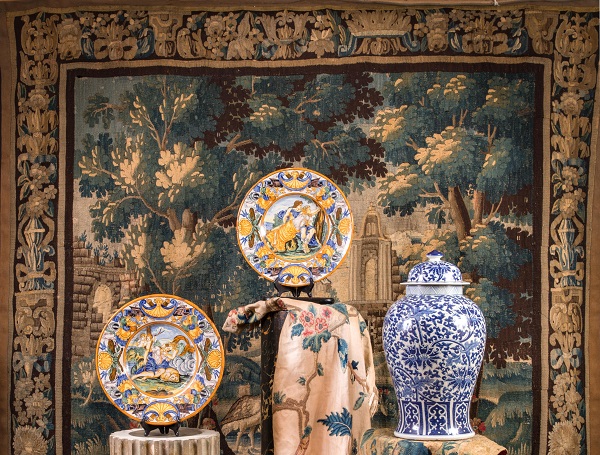Last month the medieval Devonshire Hunting Tapestries were returned on loan to their original home at Chatsworth House. Having been held by the Government since the 1950’s and displayed at the Victoria and Albert Museum, they are now on display at the Sculpture Gallery at Chatsworth until January. This news shone a spotlight on tapestries, which have seen a renaissance in popularity as the trend for pattern and colour continues to gather pace with some of the foremost designers of today.

Vignette with a tapestry, ahead of Cheffins Fine Sale in April
Large-scale tapestries have graced the walls of some of the country’s largest and most important homes since the Tudor period, and the real heyday of tapestry-making was from the second half of the fourteenth century to the end of the 18th century. It is recorded that Henry VIII had at least 2000 tapestries to adorn the walls of his palaces, some of which can still be seen at Hampton Court Palace today. They remained popular in the 17th century despite aristocratic growing interest in paintings, however, tapestries became less fashionable towards the end of the 18th century when they did not suit the Neoclassical and Romantic tastes of the time. Wallpaper was also becoming increasing en vogue, and as a result of this, combined with the disruption caused by the French Revolution and the Napoleonic Wars, the Brussels workshops, which were some of the main producers of tapestries, were eventually closed, bringing a stop to tapestry production in Europe. Nevertheless, despite their age and the lives which they have led, there is a surprising number of ancient tapestries still in existence which from time to time come available at auctions or within the antiques trade.

Verdure tapestry, circa 1700, sold for £3,600 at Cheffins Fine Sale in April
There was a revival of interest in tapestries in the 19th century with Morris & Co. producing a series for domestic interiors, with tapestries suiting the Arts & Crafts movement and the architecture of 1930s buildings, such as those designed by Edwin Lutyens. As fashions moved on, tapestries fell out of favour in the 1960s, when tastes turned towards the more minimalist Danish and Scandinavian furnituremakers and when clean lines became the order of the day. During this period, tapestries would be sold off cheaply, or relegated to attic rooms and left to gather dust, with some even tragically cut up to fit another smaller space or room. At this point, tapestries could be purchased cheaply despite condition or age, perhaps for only a few hundred pounds. However, we are now seeing a revival for these wall hangings, with tapestries featuring in recent projects by the likes of Robert Kime, Martin Brudnizki and Carlos Garcia, and this has led directly to an increase in values at auction. For example, two fabulous verdure tapestries which were sold at the Cheffins Fine Sale in April, made around four times their pre-sale estimates, both selling to private buyers.

A La Marche verdure tapestry, circa 1700, sold for £5,200 at Cheffins Fine Sale in April
The joy of a tapestry is that it can be moved from room to room, creating backgrounds for new focal points throughout the house. Originally created to cover vast draughty walls and to be lit by candlelight, they are now providing the perfect backdrop for more modern furniture even in smaller properties. For people buying an antique tapestry, it is important to be understanding that many of these have not weathered the tests of time too well, so less than perfect condition can be forgiven in a lot of circumstances. However, do look out for a good element of colour, with a piece which ideally has not been too bleached if it has been hung in direct sunlight, or more detrimental damage such as moth.
Anyone looking for a tapestry should keep an eye on our regular Fine Sales. Later this month we will be selling two tapestry upholstered armchairs from the 17th century, which would be perfect for a including an element of this trend. To view the catalogue entry, click here.